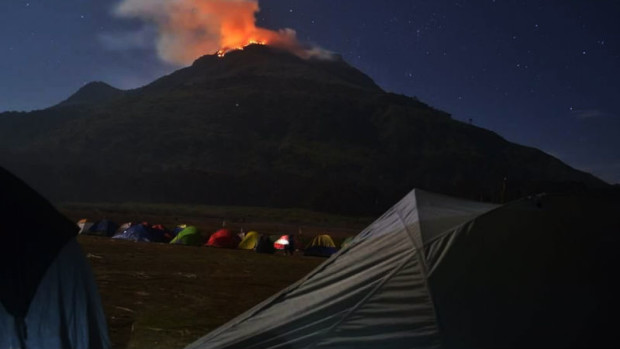Strong winds rekindle fire in Mt. Apo; wild animals flee

Trekkers who evacuated Mt. Apo on Sunday watch from a safe distance smoke from the fire raging in the northwestern side of the country’s highest peak. RYAN MARK ASTURIAS/CONTRIBUTOR
DIGOS CITY, Davao del Sur – Aided by strong wind, the fire that broke out in Mt. Apo on Saturday raged anew on Tuesday evening but fire fighters hoped it would not breach the fire line that volunteers had started putting up, officials said Wednesday.
An official also disclosed that wild animals had fled the mountain following the devastating fire.
Harry Camoro, Davao del Sur provincial risk reduction management officer, said more than 100 volunteers have been working double time in the sitios of Tumpis and Kolan in Sta. Cruz, Davao del Sur, to prevent the fire from eating up the centuries-old Almaciga tree, a landmark along the Sibulan Trail in Sta. Cruz, as fire continued to spread towards the area of Talomo.
The volunteers, armed with such tools as shovels and machetes, went up near the fire zone to conduct clearing operations, he said.
“The fire rekindled on Tuesday night due to strong wind and was expected to eat more areas as it is now within the Talomo side,” Camoro said, adding that the establishment of a fire line has continued “as means of controlling the fire.”
Article continues after this advertisementHe said the volunteers would likely spend long hours in the area but they had ample supply of canned goods, noodles, rice and water – which were donated by concerned groups and individuals.
Article continues after this advertisementMore volunteers were also expected to join the clearing operations, Camoro said, after the arrival of dozens of members of the indigenous communities in North Cotabato in Barangay Kapatagan here on Wednesday.
Eduardo Ragaza, national parks supervisor of the Department of Environment and Natural Resources (DENR) in Southern Mindanao said the Philippine Air Force helicopter has resumed dousing the flame, which had burned more than 300 hectares of forest and grass lands since Saturday. The Air Force has been dumping water scooped from a lake in Barangay Kapatagan.
Camoro said a drone from Davao City’s Central 911 has also conducted a survey of the affected area on Wednesday. The result of the survey, he said, would be used to determine the extent of the damage caused by the fire, which started near the mountain’s peak on Black Saturday.
Aside from determining the extent of the damage, Camoro said the aerial survey would also help determine which areas the fire line should run.
Ragaza said their focus has been to put off the fire as soon as possible.
He said the investigation on who actually started the fire would come later although they have come to believe that it was started by a group of campers.
Ragaza also said it was found out that more than 1,000 climbers ascended Mt. Apo during the Holy Week even if there cap on the number was placed on 1,000 as agreed upon by local government units around the country’s highest peak.
For example, Sta. Cruz listed more than 500 climbers, who were allowed to pass through the Sibulan Trail.
Nelly Nita Dillera, director of the Department of Tourism in Central Mindanao, said the establishment of fire lines would effectively prevent the fire from spreading.
“Let’s pray that the fire will be contained soon in the country’s highest peak,” she said.
Dillera added she would recommend the shutting down of Mt. Apo for at least five years to allow it to recover from the devastating fire.
“I am initially recommending closing it (to climbers) for five years,” she said.
In Kidapawan City, there has been a massive movement of wild animals monitored in Mt. Apo since the fire struck, Joey Recimilla, the city tourism officer.
He said volunteers, who put up a fire line on the North Cotabato side of the country’s highest peak, had found tracks and droppings of various animals, which obviously fled the fire.
“These are all indications that animal movement or migration is happening in the mountain,” Recimilla said.
He said based on the tracks and droppings, the wild animals – including wild boars, rats, lizards, birds and deer – went toward the area of Lake Venado and other places they felt safe from the fire. SFM